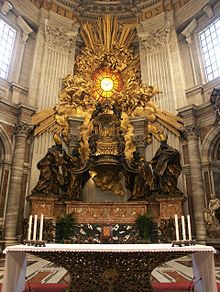
Back Müqəddəs Pyotr kafedrası Azerbaijani Кафедра Святога Пятра Byelorussian Cathedra Petri Czech Cathedra Petri (Kunstwerk) German Katedro de Sankta Petro Esperanto Cátedra de San Pedro Spanish Pyhän Pietarin istuin Finnish Chaire de saint Pierre French Kursi Santo Petrus ID Cattedra di San Pietro Italian
| Chair of Saint Peter | |
|---|---|
| Latin: Cathedra Petri | |
 | |
| Artist | Gian Lorenzo Bernini |
| Year | 1657–1666 |
| Catalogue | 61 |
| Type | Sculpture |
| Medium | Gilt bronze |
| Location | St. Peter's Basilica, Vatican City |
| 41°54′8″N 12°27′12″E / 41.90222°N 12.45333°E | |
| Preceded by | Habakkuk and the Angel (Bernini) |
| Followed by | Saints Jerome and Mary Magdalen (Bernini) |

The Chair of Saint Peter (Latin: Cathedra Petri), also known as the Throne of Saint Peter, is a relic conserved in St. Peter's Basilica in Vatican City, the sovereign enclave of the Pope inside Rome, Italy. The relic is a wooden throne that tradition claims belonged to the Apostle Saint Peter, the leader of the Early Christians in Rome and first Pope, and which he used as Bishop of Rome.[1] The relic is enclosed in a sculpted gilt bronze casing designed by Gian Lorenzo Bernini and constructed between 1647 and 1653.[1] In 2012, Pope Benedict XVI described the chair as "a symbol of the special mission of Peter and his Successors to tend Christ's flock, keeping it united in faith and in charity."[2]
The wooden throne was a gift from Emperor of the Romans Charles the Bald to Pope John VIII in 875.[1] It has been studied many times over the years, most recently between 1968 and 1974.[3] The study concluded that it was not a double, but a single chair, with a covering, and that the oldest parts are from the 6th century.[3] The Chair of Saint Peter is the second altar within the church, with the first one being the one under St. Peter's Baldachin. It stands to remind visitors of the Catholic Church's authority.[4]
On 27 October 2024, the newly restored chair was shown in public for the first time since 1867, on a decision by Pope Francis. After the concluding Mass of the Synod on Synodality, it was centered in front of the baldachin.[5] By the 28 October, the chair was in front of the right front pillar, and then on 26 November 2024 it was returned to the reliquary.[6] The chair was due to be on display until 8 December 2024.[7]
- ^ a b c "Interior of the Basilica". Vatican State. Archived from the original on 16 May 2017. Retrieved 20 March 2013.
- ^ Akin, Jimmy (February 20, 2013). "9 things you need to know about the "Chair of St. Peter"". National Catholic Register. Retrieved 23 March 2016.
- ^ a b "The Chair of Peter". Catholic Exchange. Sophia Institute Press. February 22, 2016. Retrieved 23 March 2016.
- ^ "Gian Lorenzo Bernini, Cathedra Petri (Chair of St. Peter) – Smarthistory". smarthistory.org. Retrieved 2023-02-23.
- ^ Jones, Thaddeus (27 October 2024). "Pope: May we be a Church on the move, sharing the joy of the Gospel". Vatican News. Vatican City: Dicastery for Communication .
- ^ cruxstationalis. "Relic Of St. Peter's Chair Returns To Its Reliquary". Instagram.
- ^ Bronková, Johana (26 October 2024). "The Baldacchino and the Altar of the Chair of St. Peter's Basilica". Vatican News.